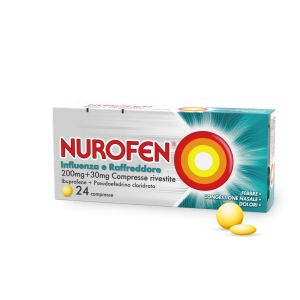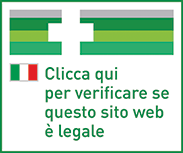Ship in Europe, Find out rates!
Nurofen Influenza e Raffreddore 200mg+30mg 24 Compresse Rivestite

- box Delivery in Italy in 24/48 and free returns
- star3.000+ positive reviews
- dropboxOver 60,000 products in the catalog
Therapeutic indications
NUROFEN INFLUENZA AND COLD 200 mg + 30 mg Coated Tablets, is indicated in adults and adolescents over 12 years. Treatment of cold and flu symptoms such as nasal and sinus congestion, pain, fever, sore throat, headache.
Dosage
Posology For a short period of treatment only. • 5 days maximum of therapy for the adult population; • 3 days maximum of therapy for the pediatric population (12-18 years). Undesirable effects can be minimized by using the lowest effective dose for the shortest possible duration of treatment needed to control symptoms (see section 4.4). If the use of the medicine is necessary for more than 5 days in adults and for more than 3 days in adolescents, or in the case of worsening of symptoms, the doctor should be consulted. Pediatric population: Do not give to children under 12 years of age. Adults and adolescents over 12 years of age: The starting dose is 1–2 tablets per day, then 1–2 tablets every 4 hours if needed. Do not exceed the dose of 6 tablets in 24 hours. Elderly: In the elderly, no modification of the recommended posology is required except in patients with renal or hepatic disorders for which it is necessary to individually adjust the dosage. Method of administration: Oral use.
Overdose
Symptoms Nausea, vomiting, abdominal pain and more rarely diarrhea may occur. Tinnitus, headache and gastrointestinal bleeding can also occur. In more severe cases of poisoning, central nervous system toxicity is observed, manifesting as dizziness, somnolence, occasionally arousal and disorientation or coma. Occasionally patients develop seizures. In severe cases of poisoning, metabolic acidosis and prolongation of prothrombin time / INR may occur, possibly caused by interference with the action of circulating coagulation factors. Acute renal failure, liver damage and respiratory depression may also occur. Exacerbation of asthma can occur in asthmatics. As with other sympathomimetics, an overdose of pseudoephedrine can cause symptoms related to central nervous system disorders and cardiovascular stimulation, including : irritability, restlessness, tremors, thirst, blurred vision, anxiety, anxiety, insomnia, fever, sweat, exophthalmos, hallucinations, muscle weakness , palpitations, convulsions, urinary retention, hypertension, difficulty urinating, nausea, vomiting, tachycardia and cardiac arrhythmias. Treatment Treatment should be symptomatic and supportive, particularly of the cardiovascular and respiratory systems, and should include maintaining a patent airway and monitoring cardiac function and vital signs until the patient is stabilized. Oral administration of activated charcoal should be considered if the patient presents within 1 hour of ingesting a potentially toxic amount. If necessary, corrective action of serum electrolytes should be used. Seizures should be treated with intravenous benzodiazepines if they are frequent or prolonged. Administer bronchodilators in case of asthma. Elimination of pseudoephedrine can be accelerated by acid diuresis or dialysis. Hypertensive phenomena can be treated with alpha IV receptor blocking drugs. Cardiac arrhythmias may require the use of beta-adrenergic blocking agents after administration of alpha-adrenergic blockers. Hyperexcitability and hallucinations can be treated with chlorpromazine.
Contraindications
Hypersensitivity to the active substances or to any of the excipients listed in section 6.1. Patients with peptic ulcer. History of gastrointestinal bleeding or perforation related to previous active treatments or history of recurrent peptic ulcer / haemorrhage (two or more distinct episodes of proven ulceration or bleeding). Subjects who have previously shown hypersensitivity reactions (such as nasal polyposis, asthma, rhinitis, angioedema or urticaria) following the use of ibuprofen, acetylsalicylic acid or other analgesics, antipyretics, other non-steroidal anti-inflammatory drugs (NSAIDs). Severe renal or hepatic insufficiency. Severe heart failure (NYHA class IV) Patients with serious cardio-vascular diseases, tachycardia, hypertension, angina pectoris, hyperthyroidism, diabetes, pheochromocytoma, glaucoma, prostatic syndrome. Pregnancy. Breastfeeding (see section 4.6). Children under 12 years old. Patients taking or have taken within the previous 14 days monoamine oxidase inhibitors (MAOIs) (see section 4.5).
Side effects
The list of undesirable effects below includes those which have been observed during treatment with ibuprofen at self-medication dosages (up to a maximum of 1200mg per day) and with sympathomimetics including pseudoephedrine for short periods of administration. Undesirable effects associated with the administration of ibuprofen and sympathomimetics such as pseudoephedrine are listed below by system organ class and frequency. For the frequency of occurrence of undesirable effects, the following expressions are used: Very common ( ≥ 1/10) Common ( ≥ 1/100 to <1/10) Uncommon ( ≥ 1/1000 to <1/100) Rare ( ≥ 1 / 10,000 to <1/1000) Very rare (<1 / 10,000), not known (frequency cannot be estimated from the available data) Within each frequency class, undesirable effects are presented in decreasing order of severity. Table of undesirable effects
| System and organ classification | Frequency | Adverse Reaction |
| Disorders of the blood and lymphatic system | Uncommon | Hypersensitivity reactions characterized by hives and pruritus 2 |
| Very rare | Hematopoietic Disorders 1. Severe hypersensitivity reactions. Symptoms can be: swelling of the face, tongue and larynx, dyspnoea, tachycardia, hypotension (anaphylaxis, angioedema or severe shock) .2 | |
| Psychiatric disorders | You don't notice | Insomnia, anxiety, restlessness, agitation, hallucinations. |
| Nervous system disorders | Uncommon | Headache, tremors |
| Very rare | Aseptic meningitis 3 | |
| Cardiac pathologies | Not known | Heart failure and edema4, tachycardia, chest pain, arrhythmia, palpitations. |
| Vascular pathologies | Not known | Hypertension 4 |
| Respiratory, thoracic and mediastinal disorders | Not known | Respiratory system reactivity including asthma, bronchospasm or dyspnoea 2 |
| Gastrointestinal disorders | Uncommon | Abdominal pain, nausea and dyspepsia 5 |
| Rare | Diarrhea, flatulence, constipation and vomiting | |
| Very rare | Peptic ulcer, gastrointestinal perforation or haemorrhage, melaena, haematemesis, sometimes fatal, particularly in the elderly (see section 4.4). Ulcerative stomatitis, mouth ulcerations, gastritis. | |
| Not known | Dry mouth Exacerbation of colitis and Crohn's disease (see section 4.4). | |
| Hepatobiliary disorders | Very rare | Liver problems |
| Skin and subcutaneous tissue disorders | Not known | Hyperhidrosis |
| Uncommon | Skin rashes 2 | |
| Very rare | Bullous reactions including Stevens – Johnson syndrome, erythema multiforme and toxic epidermal necrolysis may occur. | |
| Musculoskeletal and connective tissue disorders | Not known | Muscle weakness |
| Renal and urinary disorders | Very rare | Severe renal insufficiency 6 |
| Not known | Urinary retention | |
| General disorders and administration site conditions | Not known | Irritability, thirst |
| Diagnostic tests | Very rare | Decrease in the level of hemoglobin in the blood |
Pregnancy and breastfeeding
The product should not be used during pregnancy and lactation. Pregnancy: Inhibition of prostaglandin synthesis may adversely affect pregnancy and / or embryo / fetal development. Results of epidemiological studies suggest an increased risk of miscarriage and cardiac malformation and gastroschisis after use of a prostaglandin synthesis inhibitor in early pregnancy. The absolute risk of cardiac malformations increased from less than 1% to approximately 1.5%. The risk was considered to increase with dose and duration of therapy. In animals, administration of prostaglandin synthesis inhibitors has been shown to cause an increase in pre- and post-implantation loss and embryo-fetal mortality. In addition, an increased incidence of various malformations, including cardiovascular, has been reported in animals given prostaglandin synthesis inhibitors during the organogenetic period. During the third trimester of pregnancy, all prostaglandin synthesis inhibitors can expose the fetus to: - cardiopulmonary toxicity (with premature closure of the arterial duct and pulmonary hypertension); - renal dysfunction which can progress to renal failure with oligo-hydroamnios; The mother and the newborn, at the end of pregnancy, to: - possible prolongation of the bleeding time, an antiplatelet effect which can occur even at very low doses; - inhibition of uterine contractions resulting in delayed or prolonged labor. There is a possibility of an association between the onset of fetal abnormalities and taking pseudoephedrine in the first trimester of pregnancy. Breastfeeding: Although ibuprofen is present in breast milk in very low concentrations, pseudoephedrine is secreted in milk in significant quantities; for this reason the product should not be used during breastfeeding. Fertility: As with other NSAIDs, the use of NUROFEN INFLUENZA E COLFFREDORE can alter female fertility by effecting ovulation. Therefore it is not recommended in women who wish to conceive.
Special warnings
Undesirable effects can be minimized with the use of the lowest effective dose for the shortest possible duration of treatment needed to control symptoms (see section 4.2 and below on Gastrointestinal and Cardiovascular Risks). Other NSAIDs: The use of NUROFEN FLU AND COLD should be avoided in conjunction with NSAIDs, including selective COX-2 inhibitors. Avoid the simultaneous use of two or more analgesics, antipyretics, non-steroidal anti-inflammatory drugs, as this involves an increased risk of undesirable effects. The use of NSAIDs should be carefully considered in patients with coagulation disorders as a reduction in coagulability is possible. The same applies to patients being treated with oral anticoagulants, due to the possibility of a potentiation of the anticoagulant effect (see also section 4.5). Gastrointestinal safety: as with all anti-inflammatories, the drug should not be taken if the patient is suffering from ulcer or gastric disorders. Gastrointestinal bleeding, ulceration and perforation: Gastrointestinal bleeding, ulceration and perforation, which can be fatal, have been reported during treatment with all NSAIDs, at any time, with or without warning symptoms or a previous history of serious gastrointestinal events. In the elderly and in patients with a history of ulcer, particularly if complicated with haemorrhage or perforation (see section 4.3), the risk of gastrointestinal bleeding, ulceration or perforation is higher with increasing doses of NSAIDs. These patients should start treatment with the lowest available dose. Concomitant use of protective agents (misoprostol or proton pump inhibitors) should be considered for these patients and also for patients taking low doses of acetylsalicylic acid or other drugs that may increase the risk of gastrointestinal events (see below section 4.5). Patients with a history of gastrointestinal toxicity, particularly the elderly, should report any unusual gastrointestinal symptoms (especially gastrointestinal bleeding) particularly in the initial stages of treatment. Caution should be exercised in patients taking concomitant medications which may increase the risk of ulceration or bleeding, such as oral corticosteroids, anticoagulants such as warfarin, selective serotonin reuptake inhibitors or antiplatelet agents such as acetylsalicylic acid (see section 4.5). When gastrointestinal bleeding or ulceration occurs in patients taking NUROFEN FLU AND COLD the treatment should be discontinued. NSAIDs should be administered with caution to patients with a history of gastrointestinal disease (ulcerative colitis, Crohn's disease) as these conditions may be exacerbated (see section 4.8). Cardiovascular and cerebrovascular effects: caution is required (discuss with your doctor or pharmacist) before starting treatment in patients with a history of hypertension and / or heart failure as fluid retention, hypertension and edema. Clinical studies suggest that the use of ibuprofen, especially at high doses (2400 mg / day), may be associated with a modest increased risk of arterial thrombotic events (e.g. myocardial infarction or stroke). In general, epidemiological studies do not suggest that low doses of ibuprofen (e.g. ≤ 1200 mg / day) are associated with an increased risk of arterial thrombotic events. Patients with uncontrolled hypertension, congestive heart failure (NYHA class II-III), established ischemic heart disease, peripheral arterial disease and / or cerebrovascular disease should only be treated with ibuprofen after careful consideration and high doses (2400 mg / day) should be avoided. ). Careful consideration should also be exercised before initiating long-term treatment for patients with risk factors for cardiovascular events (e.g. hypertension, hyperlipidemia, diabetes mellitus, cigarette smoking), especially if high doses (2400 mg) are required. / day) of ibuprofen. Skin reactions: Serious skin reactions, some of them fatal, including exfoliative dermatitis, Stevens-Johnson syndrome and toxic epidermal necrolysis, have been reported very rarely in association with the use of NSAIDs (see section 4.8). In the early stages of therapy, patients appear to be at higher risk: the onset of the reaction occurs in most cases in the early stages of treatment. NUROFEN FLU AND COLD should be discontinued at the first appearance of skin rash, mucosal lesions or any other signs of hypersensitivity. Respiratory disorders: bronchospasm may arise in patients with bronchial asthma or current or previous allergic diseases. Do not take the product in cases of asthma and allergy to acetylsalicylic acid unless after consulting your doctor (see section 4.3). SLE and mixed connective tissue disease: in the case of systemic lupus erythematosus and mixed connective tissue disease it may lead to an increased risk of aseptic meningitis (see section 4.8). Renal function: renal failure, as renal function may be impaired (see sections 4.3 and 4.8). Hepatic function: hepatic dysfunction (see sections 4.3 and 4.8). Impaired female fertility: see section 4.6 regarding female fertility. To be used with caution in combination with antihypertensives including neuronal adrenergic blockers and beta blockers (see section 4.5). To be used with caution with other sympathomimetic agents such as decongestants, appetite suppressants and amphetamine psycho-stimulants (see section 4.5). To be used with caution in case of overexcitation. If hallucinations occur; restlessness or sleep disturbances during administration of the medicinal product, use of the medicinal product should be discontinued. Elderly: Elderly patients have an increased frequency of adverse reactions to NSAIDs, in particular gastrointestinal haemorrhage and perforation which can be fatal (see section 4.2). Pediatric population: There is a risk of renal impairment in dehydrated adolescents.
Expiry and Retention
This medicinal product does not require any special storage conditions.
Active principles
One tablet contains: ibuprofen 200 mg, pseudoephedrine hydrochloride 30 mg. For the full list of excipients, see section 6.1.
Excipients
Tricalcium phosphate, sodium carboxymethylcellulose, microcrystalline cellulose, povidone, methylhydroxypropylcellulose, magnesium stearate, talc, dyes: E 104, E 110, E 171.


